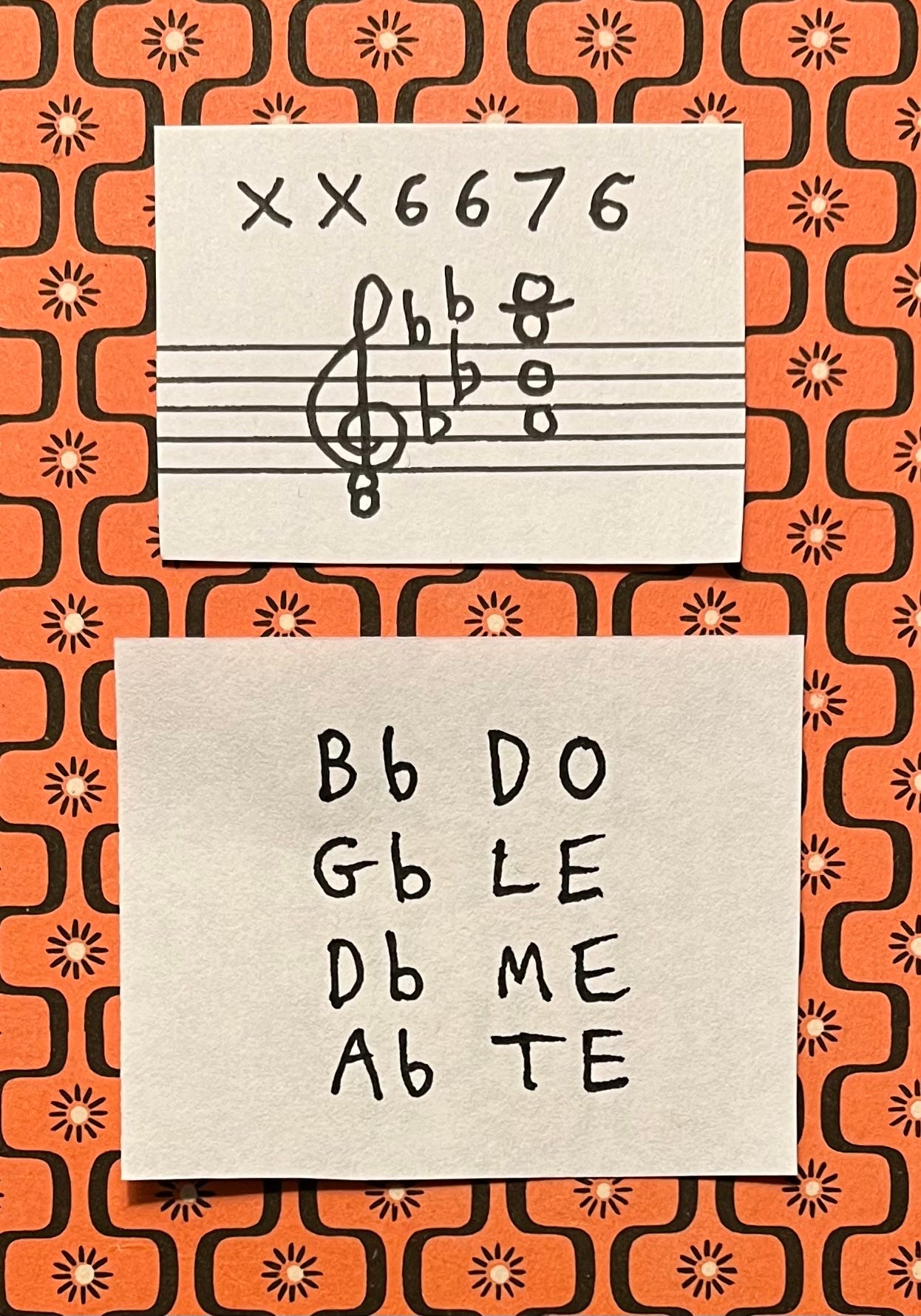CW54
I was part of the live ensemble that recorded the new Fievel Is Glauque album, Rong Weicknes. Zach Phillips and I are old friends. 💕 At the end of “Eternal Irises,” the second-to-last song, I improvised a little coda that doesn’t land where you expect. I want to look at it today.
As some reviewers understand, and some don’t quite, we made the album this way: First the entire band (including Ma Clément’s vocals—real takes, not just scratch vocals) would record the whole song together live. Then we’d all double-track what we’d just done, playing along with the first pass (and each other again) on our headphones. And then we’d do one more pass, but crazy: we were free to lay out, highlight stuff, fight the order we’d just established, whatever. All this, plus a handful of individual overdubs made on the final day, were then painstakingly mixed over many months.
“Eternal Irises” begins with an elaboration of the first three chords of John Coltrane’s “Giant Steps”—in the same key, B, no less—and then goes elsewhere. Unlike “Giant Steps,” though, as flowery a beauty as “Eternal Irises” is, it can’t be said to really modulate much. To my ear, the song essentially stays in B throughout.
But the final chord is a surprise. It’s written on the chart as “A#m9 add b13.” (The A# spelling makes sense in context (in B), but I thought of it as a Bbm, so moving forward I’m going to talk about it that way.) Playing a plugged-in rubber-bridge acoustic steel-string, I get there first with this voicing:
The band quickly drops in and swirls around it, filling out and clarifying the harmony.
(I chose a voicing that could also be LA RE SO TI (low to high) of a Bmaj7 chord, if that were what was following at my heels. I won’t pretend to remember if this ambiguity, which I worked out ahead of time, was why I jumped ahead of the pack. But it’s a neat little misdirection when it falls first.)
It seemed like the song was going to end on a minor chord a half-step below where the song had mostly lived, until, with a lovely little parallel fifths thing, bassist Logan Kane, who was just to my right, moved the whole thing to the relative major: Db. I’m not certain, but I believe this happened on the first pass.
My coda probably happened on the third pass—on the first two I was pretty much just strictly playing the part I’d prepared (which included doubling Ma’s melody on the chorus, watching her closely and trying to follow her phrasing exactly).
I believe the upper-octave Db above the F (you can hear these notes fade in, but the three in parentheses are the most prominent) that you hear me playing just before the coda proper is from the second pass. It’s hard to say, given that those pitches make as much sense over Bbm, but I believe I’m intentionally playing Logan’s Db chord from the first pass. But I get there a little before him because I know what that first one of him is going to do!
Though my coda could arguably arise just as easily from Bbm as from Db, I remember playing it over Db, over the key a whole-step above the original tonic—a (collective—it takes a village 💕) truck-driver modulation through an intermediary key.
I start with an almost-pedantic little walkdown to show where we’ve just been: Db C Bb, sounding as DO TI LA—like the “yeah yeah yeah”s of the Beatles’ “She Loves You.” (“All You Need Is Love” is also built from this motif (both songs are in G), but it’s been moved from the melody down into the bass—Lennon acknowledges the similarity by singing the “yeah yeah yeah”s over the outro.) But unlike “She Loves You,” I don’t repeat the LA and cadence on it, on an added-sixth chord. Instead I start repeating the figure, lowering the bottom note chromatically each time. I seem to be about to play something like this:
I distinctly, though, remember hearing, as I was looking down at my hand playing it, not a G (FI) to Gb (FA), but instead a G (LE) to F# (SO). And then my hand popped up and cadenced on B. And that was all it took to reverse the truck-driver modulation: one note. Rewind back to the beginning of the song and you’ll hear that, ironically, the unexpected modulation takes you back, ouroboros-style, to where the song began. It’s actually home. What makes it cool to me is that it was not an idea. I just felt something shift and I followed it. I melted back to B spontaneously.
There’s another thing I like about ending on B. This Db to C keeps jumping down one deeper to get another note of the chromatic scale, almost as if compulsively trying to cover all ground below Db. But because the pattern began with Db C Bb, one note was left out, like part of the floor was missed with the vacuum cleaner. Jumping up to B is like where the music realizes the omission and pops over to take care of it.
Also, as I’ve written before, I think of B as my signature key, so I’m always happy when it’s the right place to B. 💕



